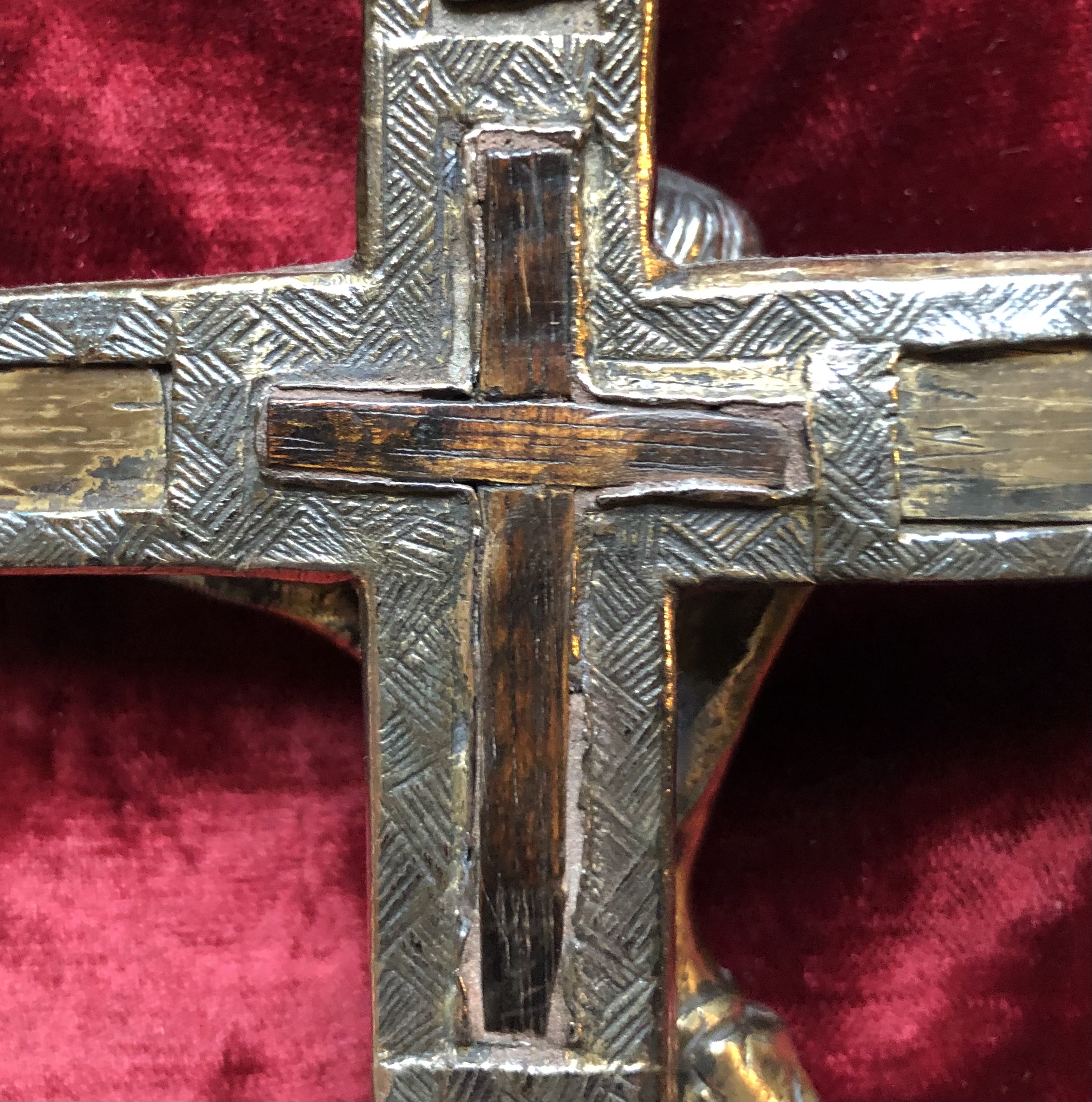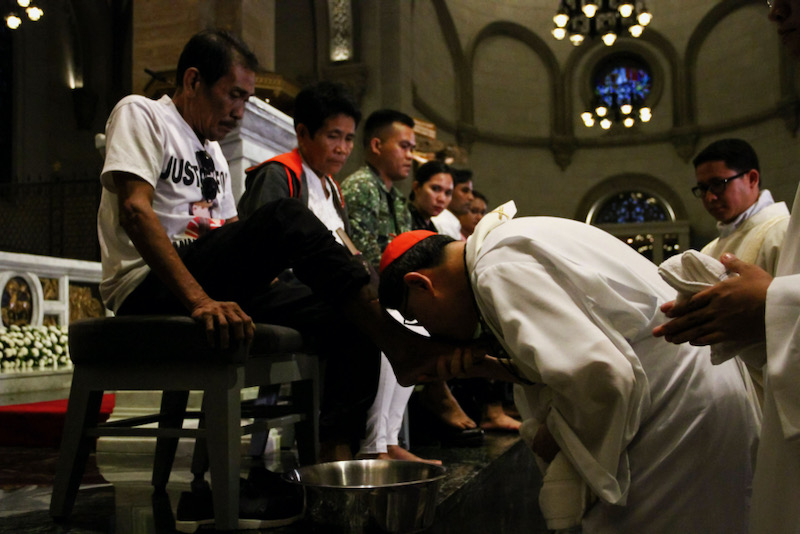At some stage in my teenage years, I must have gone to the Mass of the Lord’s Supper. That is perhaps surprising, since it was neither the epicentre of Catholic devotions back then (Good Friday was definitely Top Trumps) nor top of the average adolescent’s “to do” list. Nonetheless, I have a mental image of a dozen old men sitting on chairs on the sanctuary of our now-demolished parish church, each smartly attired, their right shoe off and attendant trouser leg hoiked up to let the parish priest pour water without wetting their turn-ups. It all looked a bit masonic!
I probably next encountered ritual foot-washing in seminary. Still 12 men, of course, albeit four decades younger than those I’d seen back home. However, since ordination I’ve always been an equal opportunities foot-washer, seeking a parity of the sexes and a full range of ages for the Rite.
At some point during my first parish assignment we switched to the clergy washing only six people’s feet and those each then going to wash one another’s (including the priests’). The “chain reaction” was meant to move beyond the view of the presbyter as the representative of Christ, set over against the community and “doing unto” them. He is also fellow disciple, in need of Jesus’ humble care, just as the parishioner is both Christ the served (Mt 25.40) and Christ the Servant (Jn 13.15). Whether or not it was “liturgically correct” (we didn’t ask), we felt it said something important about our community as a circle of mutual service.
The old description of the Church’s hierarchy as pyramidal is fine, so long as we realise that the pyramid is inverted, with Pope (or parish priest!) at the bottom of the pile, Servus Servorum Dei. True authority rests on understanding, both a standing under truth and an active undergirding of those in our care. Significantly, in John’s account (13.1-15) it is when Jesus comes to Peter that he meets the greatest resistance. The Apostle does not want Christ’s humility. Yet, however “clean” he be, the Lord demands he also own his vulnerability. Unless the call to ministry is also a desire to let Christ wash “not only my feet but my hands and my head as well!” it is a dangerous thing indeed. The tap-root of Pope Francis’ authority is his self-description: “I am a sinner.”
We easily explain away the difficulties caused by the Fourth Gospel’s account of the Last Supper (in which no cup is passed around and the only bread mentioned is the piece passed to Judas after Jesus dips it in the dish). We rationalise: John had no need to use the “words of institution” because he had already spent the whole of Chapter Six talking “eucharistically” about Jesus as the Bread of Life; and, by ‘taking as read” the Last Supper narrative, he was free to bring out the meaning of the breaking of the bread and the sharing of the cup: “Do you understand what I have done to you? … I have given you an example so that you may copy what I have done to you.”
Yes, doubtless true, but it would do us good to undertake, if only for a moment, the thought-experiment of imagining the Church having made foot-washing, rather than the breaking of bread, our habitual sacrament of communion, our anamnetic mode. Mass would certainly take longer and be messier, with bowls of water risking spillage on our nice clean floors. Sandals and pop-socks might be our Sunday morning best, whatever the weather, for their ease of removal. The way we looked at each other would certainly and quite literally change. The laity would find themselves looking down on Father, now stripped of fine vestments and with a towel around the waist, while the foot-washing cleric would unavoidably look up to the wounded humanity of those he served, as well as getting to know their bunions, corns and other signs of wear and tear. Rather than a disc of bread, the Real Presence would be found in touch, caress, an act of tender care: “This is my body,” in the person before whom I kneel. And folk would answer “Amen” to that naming recognition – a humbling culmination of the dynamic of Incarnation.
As it is, we find the Mandatum banned for a second year. Only those with legs two metres long would beat the Covid social distance rules. Touch is withdrawn again, just like the cup before. We are deprived once more of this great visual parable of Church. So in our parish church jug, bowl and towel will stand before us as mute reminders of Christ’s question (and its consequences): “Have you understood what I have done for you …?” Have we understood what Church, what Eucharist means?
It took the Vatican until 2016 to accept what we all already knew: that women also qualify for Jesus’ tender act of loving care. But we should go further than that grudging concession. It was women who taught Jesus how to bathe disciples’ feet. His mother in his infancy of course; then either Mary of Bethany in Lazarus’ home (Jn 12.3) or “the woman with a bad name in the town” (one given her by men, no doubt – Lk 7.36) in the Pharisee’s house. These taught him how to wash; but first, how to accept such tenderness.
In Mark’s account the two traditions fuse: at Bethany into the leper Simon’s house a nameless woman brought the costly nard – though she anointed head (not feet) in readiness for his burial. “Wherever, throughout the world, the gospel is proclaimed, what she has done will be told as well, in remembrance of her.” (Mk 14.9) This Maundy Thursday, even if the Mandatum be once more beyond our reach, let us all recall all those who’ve washed the feet of Christ and shown us how to kneel before wounded humanity in humble service.
Fr. Rob Esdaile is parish priest of Our Lady of Lourdes, Thames Ditton, Surrey.
(991 words + 14 words biog.)



 Loading ...
Loading ...
What do you think?
You can post as a subscriber user ...
User comments (0)